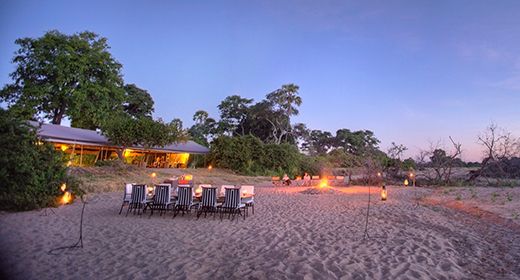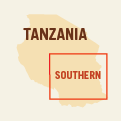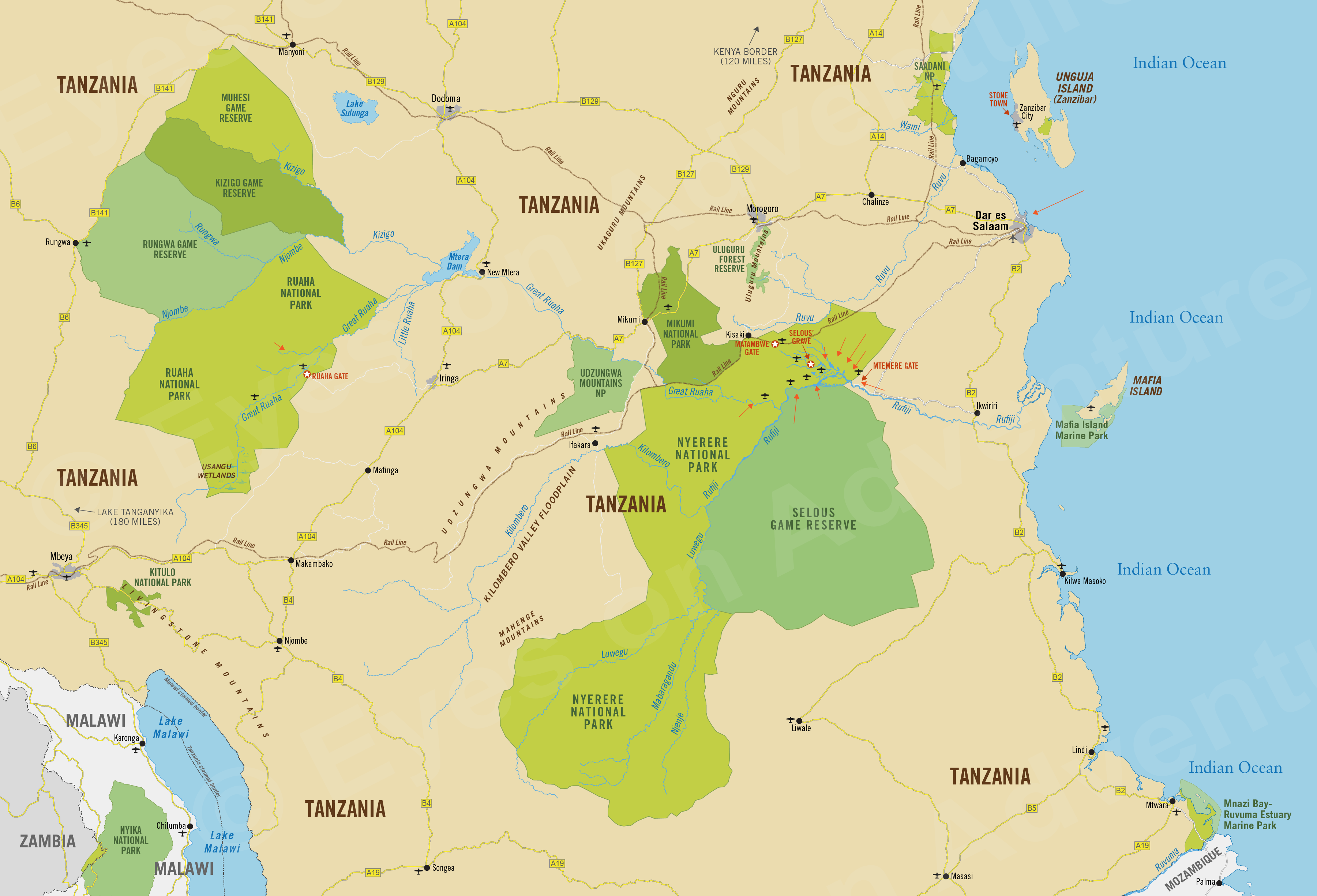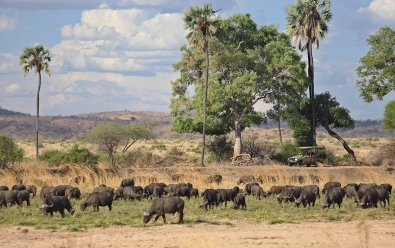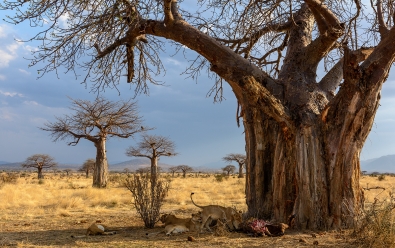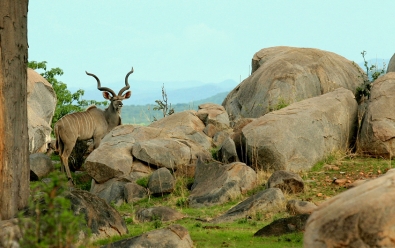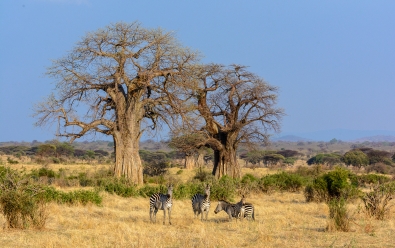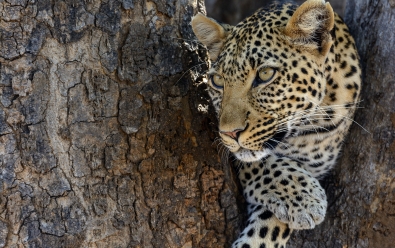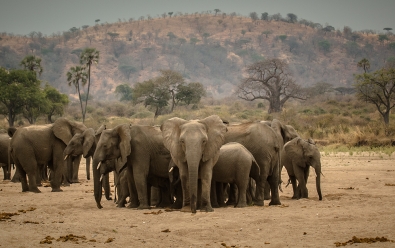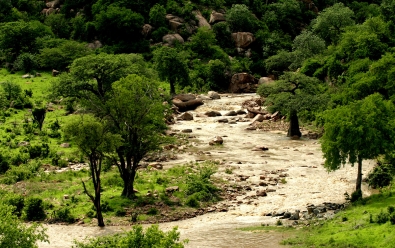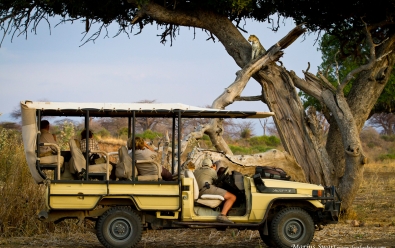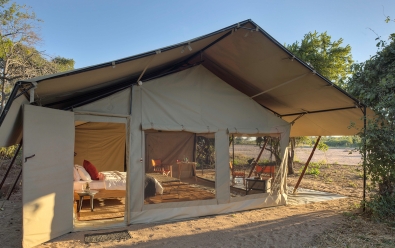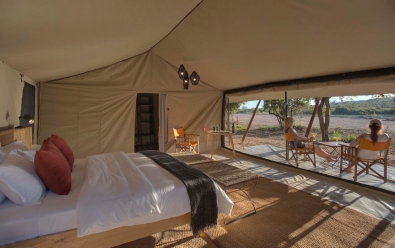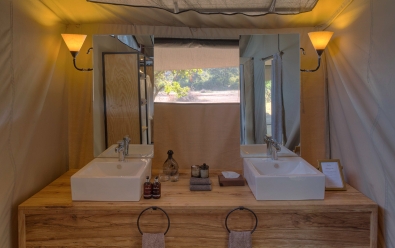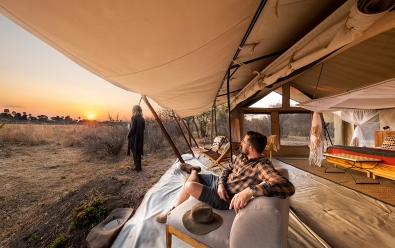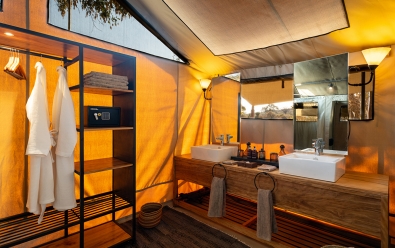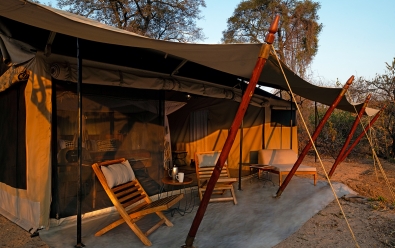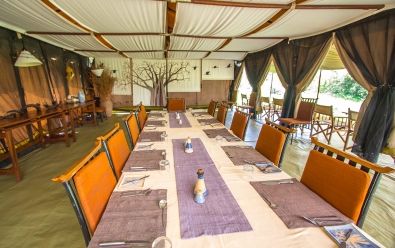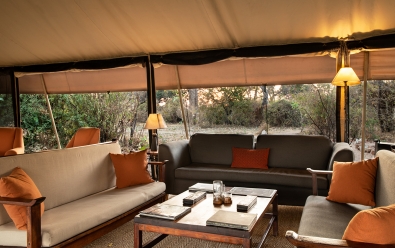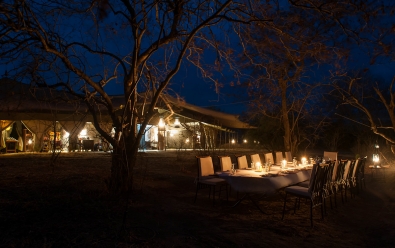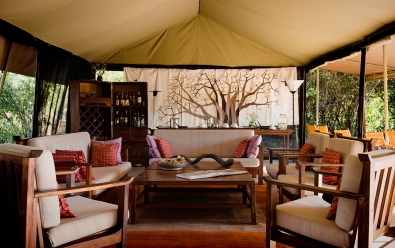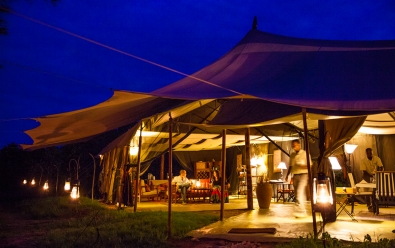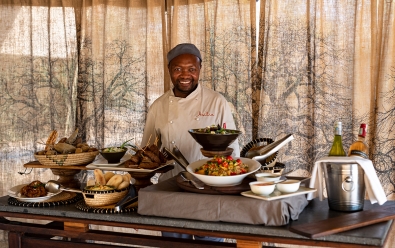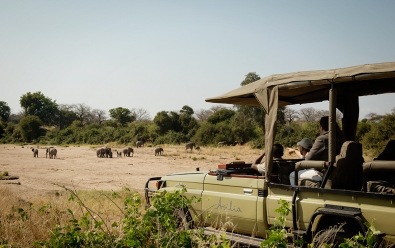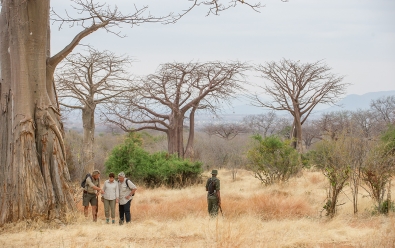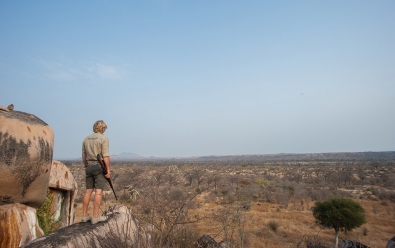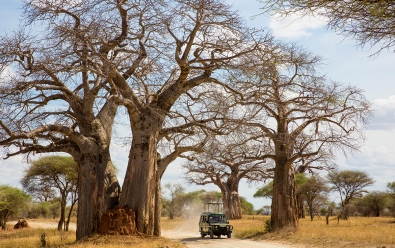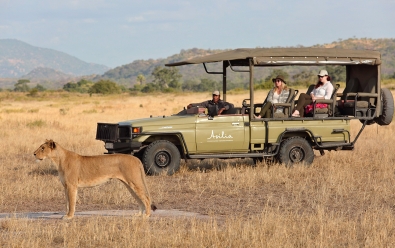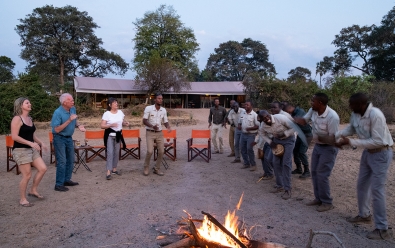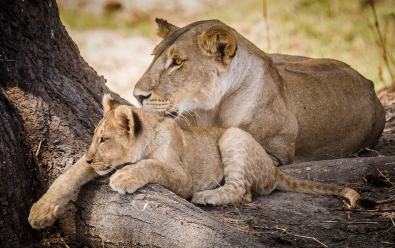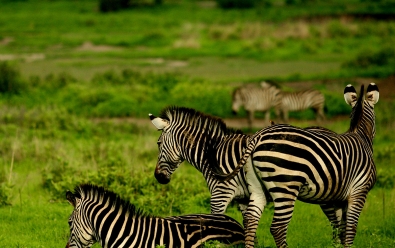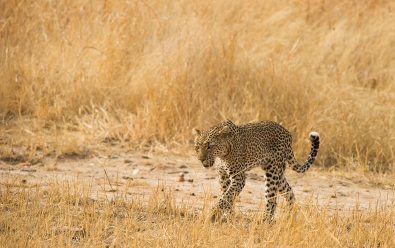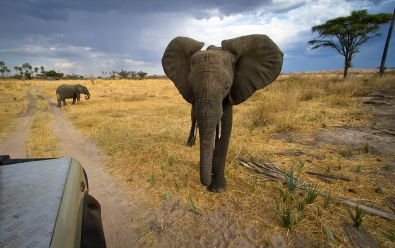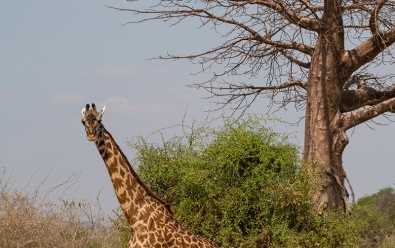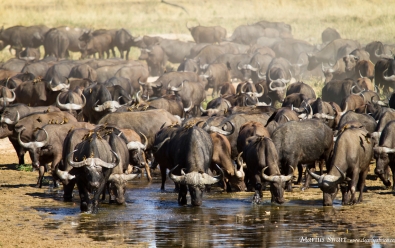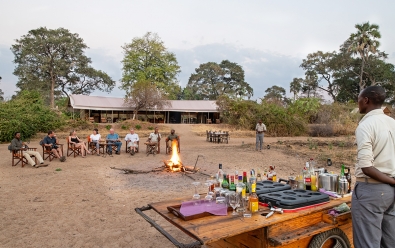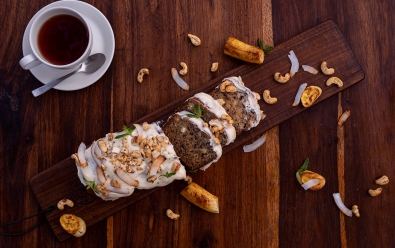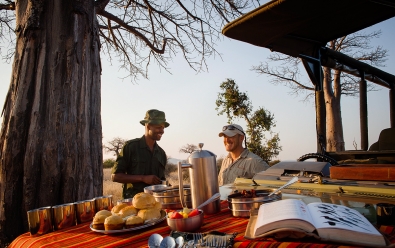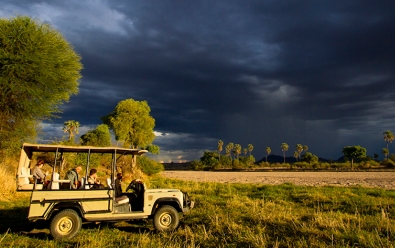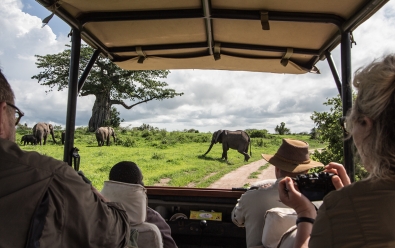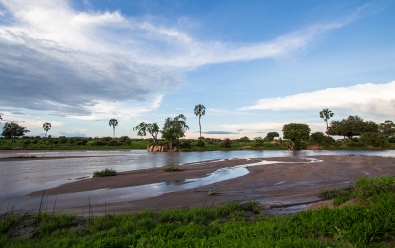Kwihala Camp
Inquire for lodging prices
Highlights
- Classic, tented camp in a prime game-viewing location
- Spectacularly scenic, abundant wildlife, and no crowds
- Game drives, bush walks, cultural visits, conservation experiences
- Excellent add-on to a northern Tanzania safari
Location
- Mwagusi River
- Ruaha National Park
- Southern Tanzania
Kwihala is a classic, tented safari camp located on the banks of a seasonal river in a prime game-viewing location within Tanzania's largest national park.
The camp is situated on the banks of the Mwagusi River, a seasonal tributary of the Great Ruaha River, which is the only permanent source of water in the wildlife-rich Ruaha National Park. The camp's position along the waterway makes it an ideal base to see wildlife while exploring a true wilderness.
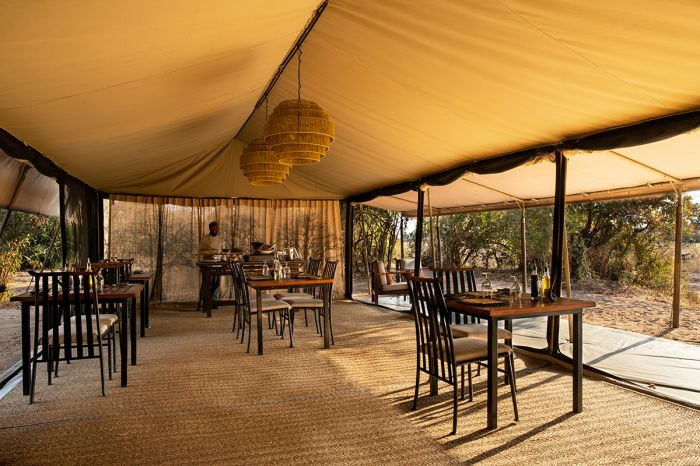
Main area dining at Kwihala Camp.
Activities at Kwihala include game drives to see the park's abundant wildlife, night drives to see some of its nocturnal animals, and superb bush explorations on foot to get a completely different perspective. The camp also offers a customized photographic game drive vehicle that features swivel seats and fold-down side panels for low-level images.
Other activities include a cultural visit to meet with the local Hehe tribe and learn about the lifestyle and their ancestral ways of life. Conservation is an integral focus at Jabali Ridge and guests can enjoy two different evening presentations to learn about their work. The Southern Tanzania Elephant Program (STEP) works to alleviate human-elephant conflict, while the Usangu Wetlands Conservation Project aims to protect crucial wetlands in the southeastern part of the park.
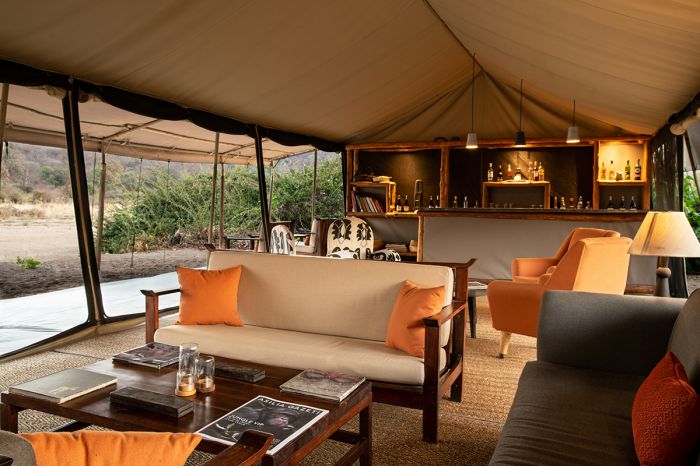
Main area lounge and bar at Kwihala Camp.
Kwihala Camp offers six, classic, Meru-style safari tents. The tents simple, yet very comfortable and include the necessary comforts. The en-suite facilities are not plumbed, but include bucket showers (hot water provided), wash basins, and flush toilets.
The main camp area includes a single, open-plan, tented space that includes a lounge, dining area and bar. Dining is often al fresco in front of the main area tent or on the usually dry, sandy riverbed in front of the camp. The romantic campfire is a popular place for drinks and discussion in the evenings. The landscape around the camp is spectacular, with numerous baobab trees, tall palms, and rock-strewn plains.
Ruaha is easily reached from the oft-visited northern Tanzania parks and is an excellent choice as an add-on for travelers who want to add diversity to a Serengeti safari experience.
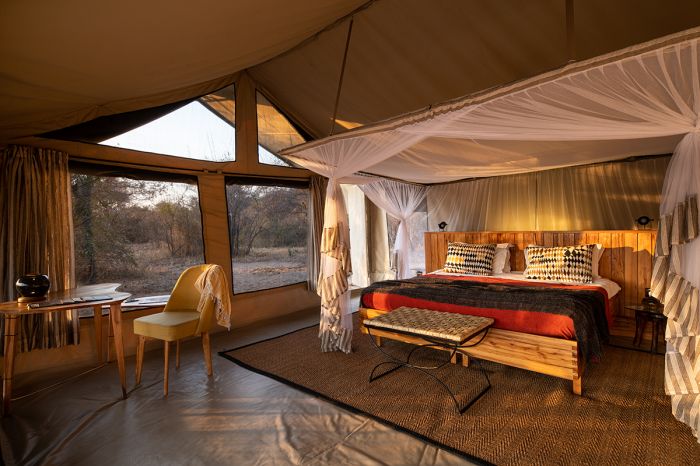
Guest tent interior at Kwihala Camp.
ABOUT RUAHA NATIONAL PARK
Ruaha National Park was originally declared in 1964 and has increased in size from that time, today covering 7 840 square miles (20 300 sq kms). The park is situated in Tanzania's Rift Valley and is the country's second-largest national park after Nyerere National Park (part of The Selous).
Ruaha National Park is the core area of a much larger protected area that includes three additional contiguous game reserves: Rungwa, Kizigo, and Muhesi. Ruaha is one of the least visited wildlife sanctuaries in Tanzania and visitors here will enjoy a true wilderness experience.
Ruaha's location is in the transitional zone between Eastern and Southern Africa, giving it a tremendous diversity of flora and fauna. Over 1 500 plant species and all the wildlife one can see in the Northern Tanzania parks are also present in Ruaha.
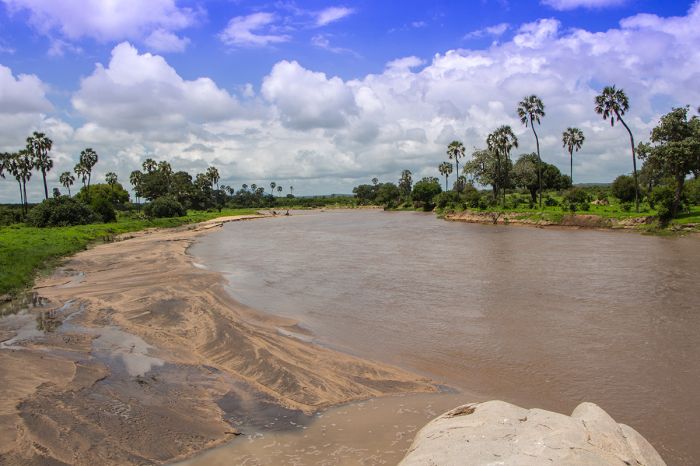
The Mwagusi River in flow at Kwihala Camp.
The park is named for the Great Ruaha River, which flows northeast through the national park, after which it bends southeast and enters Nyerere National Park, where it joins the Rufiji River, before flowing into the Indian Ocean. This river and a few of its tributaries are the only permanent sources of water in the park, which makes them the focal point for the best wildlife viewing in Ruaha.
The habitats in Ruaha are varied, with rocky outcrops and enormous granite boulders, steep gorges, sandy river banks with tall 'ilala' palm trees, and open savanna grasslands that are dotted with an abundance of baobab trees. There are also areas of Acacia and miombo woodland. The landscapes are similar to those found in some sections of Tarangire National Park to the north.
Visitors to Ruaha will see plenty of baobab trees, which are sometimes called 'the upside-down tree', which is a reference to their unique shape. The baobab (Adansonia digitata) is one of Africa's most iconic trees, with a lifespan that can exceed two thousand years. The baobab has a sullulent-like capacity to retain water and is deciduous, remaining leafless for about 8 months of the year.
Baobabs have adapted a high resistance to grass fires, which occur regularly in their savanna habitat. The tree produces large, white flowers that open for a single night beginning at sunset. During nighttime, they are pollinated hawk-moths, fruit bats, galagos (bush babies), and other insects. The dried fruits are relished by baboons, elephants, and other herbivores.
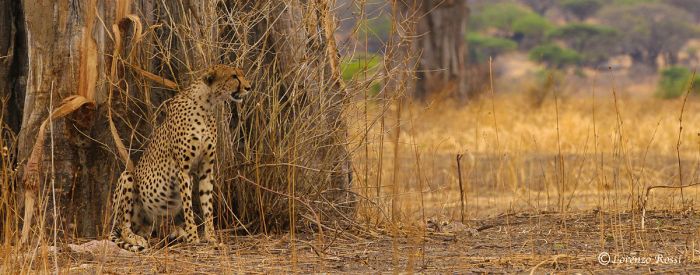
A cheetah seen near Kwihala Camp.
In terms of wildlife, Ruaha is home to large numbers of elephant, plus a number of lesser known antelopes, like sable, roan, and lesser kudu. The park also provides protection for large numbers of buffalo, as well as good numbers of zebra, eland, Grant's gazelle, impala, giraffe, defassa waterbuck, reedbuck, klipspringer, greater kudu, bushbuck, Liechtenstein's hartebeest, and Kirk's dik-dik. Ruaha is one of the few places where both lesser and greater kudu can be seen together.
The greater Ruaha region (including the surrounding game reserves and conservation areas) is home to roughly 10 percent of Africa's lion population, with some prides occasionally reaching twenty or more individuals. Besides lions, Ruaha's resident predators include healthy populations of leopard, cheetah, African wild dog, spotted hyena, black-backed jackal, and crocodile. Striped hyena are seen on occasion.
Due to the diversity of habitats occurring in Ruaha, the bird life is also diverse, with over 570 species recorded. As opposed to overall wildlife viewing, which is best during the dry season, birding is best during the rainy season, during which migratory species arrive from the north to breed.
The park has several good lodges and safari camps, many of them situated along the Great Ruaha River or one of its tributaries in the southeastern sector of the park. Game drives on tracks that follow the waterways provide excellent wildlife viewing. For the more intrepid, legendary bush walks with trained guides are on offer.
Ruaha makes an excellent destination in combination with Nyerere National Park (The Selous), which is located to the east. Ruaha can also be combined with any of the northern parks, including the Serengeti.
ROOMS INCLUDES & EXCLUDES CHILDREN FACILITIES ACTIVITIES
Accommodation
6 guest accommodations in total comprising:
- 6 classic, Meru-style, canvas tents, all of which can be set up with a double or twin beds, and three of which can be a triple to accommodate a child under the age of 16 years.
The tents include en-suite facilities (not plumbed) with a double-basin vanity, indoor bucket shower (hot water provided on request), and flush toilet. The tents are accessed via footpaths on the ground leading to the main camp area.
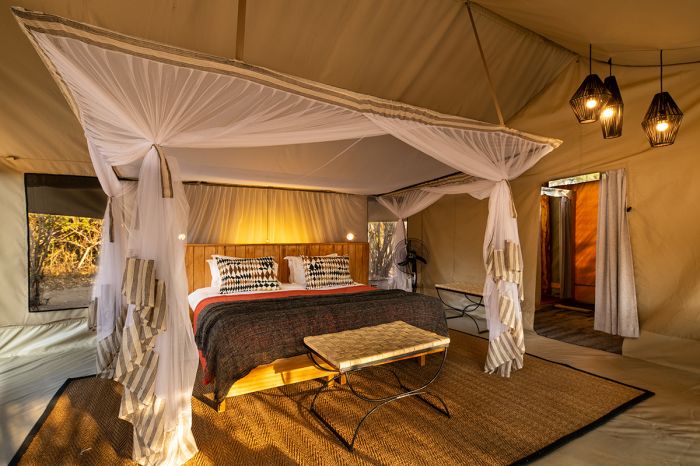
Guest tent interior at Kwihala Camp.
The camp and guest tents are situated on the bank of the seasonal Mwagusi River in one of the park's best game-viewing areas. There is a covered outdoor veranda with seating wrapping around two sides of the tent.
Other items and features in the guest tents include:
- Writing desk and chair.
- Luggage rack.
- Mosquito netting over the beds.
- Floor fan.
- Safe.
- 24-hour power (provided using a combination of solar and generator) for lighting and charging electronics.
- Hairdryers are not supported by the solar / generator power system.
- WiFi available in the main guest area only.
- Mobile phone signal available, but limited.
Kwihala Camp can accommodate a maximum of 15 guests in total: 2 persons in each of the 6 standard tents (plus one additional child in three tents).
Includes & Excludes
Includes:
- All meals and house drinks, including wines, local brand spirits and beers, teas, and coffees.
- Safari experiences (twice-daily or full-day game drives, night drives, bush walks, and birding) accompanied by an experienced guide.
- Sundowner drinks and snacks.
- Laundry services are provided on a daily basis (weather permitting, items will be returned on the same day). Laundry is dried by the sun and on most days any laundry placed out in the morning will be returned by the evening.
- Wi-Fi access (in the main guest area).
- Msembe Airstrip transfers (50-minute drive).
- Tourism Levy & VAT.
Excludes:
- Champagne, cognacs, fine wines, premium brand spirits, and cigars.
- Usangu Wetlands Conservation Project presentation.
- Southern Tanzania Elephant Program (STEP) presentation.
- Cultural visit to a local community outside the national park.
- Purchases from the Gift Shop.
- Any applicable wildlife fee, park fee, reserve fee, concession fee, other land-use fee.
Single Supplement
A single supplement may apply for any room booked by a single traveler; please ask us for pricing.
Children
Children aged 5 years and older are accommodated at Kwihala Camp:
- Three guest tents available as a triple.
- Ask us about reduced rates for children sharing with adults or children 12-17 in their own suite.
- The minimum age for children on bush walks is 12 years and at the discretion of the guide.
- Children's menu available.
- Children under 5 years are allowed in Jabali Private House or in the main camp if the camp is booked exclusively.
Game drives with children:
- During high and peak seasons, families (less than 5 persons) with children aged 0-12 years must pre-book a private vehicle.
- During low and peak seasons, families (less than 5 persons) with children aged 0-12 years will receive a private vehicle FOC subject to availability. Vehicle must be pre-booked.
- Year-round, families with children aged 0-12 years will receive a private vehicle FOC for every 5 persons in the family. This is subject to vehicle availability and must be booked in advance.
Facilities
The main camp area and guest tents are situated on the banks of the seasonal Mwagusi River in a prime wildlife-viewing area.
The main guest area consists of a single, open-plan, canvas structure supported by wooden beams on the ground, comprising a combined dining area, lounge, and bar. Roll-down canvas flaps on all sides are generally left open unless there is wind or rain. The area in front of the tented space includes a campfire and outdoor dining area.
Main guest area facilities include:
- The main guest area is a tented structure that includes a dining area, lounge, and bar.
- Dining is typically communal, but private dining is available on request.
- Campfire area.
- Gift Shop.
- Complimentary Wi-Fi access.
- Mineral water is provided in the main camp areas and in the guest tents.
- The camp is powered by a combination of solar and generator.
Activities
Activities included in the rate:
- Morning and afternoon/evening game drives in semi-open 4x4 vehicles.
- Shorter drives after dark are also possible to see some of the park's nocturnal animals.
- Guided bush walks. Children must generally be 12 years of age (or given clearance at the discretion of the guide).
- Full-day game drives with a packed picnic.
- Sundowners.
- Birding.
- Child-friendly activities.
- All game drive vehicles fitted with inverters for battery charging on game drives.
Optional activities at additional cost:
- Private activities are on offer (subject to vehicle availability, which needs to be booked in advance).
- Use of the customized Asilia photographic game drive vehicle. The vehicle is based at Jabali Ridge, but also bookable from Kwihala. Maximum three photographers. Best to reserve in advance.
- Usangu Wetlands Conservation Project presentation. Evening activity including dinner with a member of the project's team to learn about their work to conserve this key and fragile ecosystem in the southern part of the national park. Fees are a donation to the conservation project. Pre-booking required.
- Southern Tanzania Elephant Program (STEP) presentation. Elephant poaching is a serious problem in southern Tanzania and the STEP organization works to protect the region's elephants. Evening activity including dinner with a member of STEP's team to learn about their work. Fees are a donation to the conservation project. Pre-booking required.
- Guided visit to a local Hehe tribe village (full-day excursion). Alternately, an evening visit to the camp by HeHe tribe members can be arranged. Pre-booking required.
Example of a typical day:
- Early morning wake-up call. Morning wake-up and activity times vary according to the seasons, activities on offer, and wildlife sightings.
- Light breakfast before departing on the morning activity or food packed for an earlier departure.
- Return to the camp for a meal and rest period (full-day outings mean lunch is packed).
- Meet for afternoon tea and snacks (savory and sweet choices) before departing on the activity.
- Return to camp - freshen up or meet for drinks, followed by dinner.
- Enjoy a nightcap and/or discussion at the bar or around the campfire before retiring.
Great Good Fair Poor
- Jan
- Feb
- Mar
- Apr
- May
- Jun
- Jul
- Aug
- Sep
- Oct
- Nov
- Dec
GENERAL TIPS
The Ruaha region is an excellent wildlife-viewing destination throughout year, with healthy populations of all of the big cats including lion, leopard, and cheetah, as well as spotted hyena and African wild dog. Herbivores are also present in large numbers, especially elephant, giraffe, buffalo, impala, and greater kudu.
Similar to the Serengeti and Masai Mara regions further to the north, the rains in Ruaha occur between November and April and it is advisable to avoid the region during March and April, when heavy rains typically occur. June to mid-October is outstanding for wildlife viewing, especially along the various waterways, which become a focal point for the animals during the dry season.
Kwihala Camp is closed from 01-December thru 31-May.
RAINS
The rainy season in the Ruaha region is from November thru mid-May, with two distinct rain seasons. The "Short Rains" (locally called the "mvuli") fall from mid-November to mid-December and are generally lighter and less impactful to safari activities. The "Long Rains" (locally called the "masika") occur between March and May, brining afternoon showers on a near daily basis.
Short Rains
The short rains occur for about one month sometime during November and December (the exact time varies somewhat year to year). This period is called the 'short' rains because the duration of an individual rain event is short and it is rare to have an all-day rain event. Most rain falls as an afternoon shower, while mornings are typically overcast or clear.
The first rains typically arrive sometime in mid-November, but December receives the bulk of the short rains. The landscape turns verdant and thousands of migrant birds arrive. Impalas and warthogs give birth and the land feels revitalized.
January / February
January and February (the period between the 'short' rains and the 'long' rains) are unpredictable with regards to rain, as in some years the rains abate before starting again in March, while in other years, the short rains do not end and continue falling before becoming more serious in March.
Many days are clear and the amount and duration of the rain events is unpredictable, with some afternoon showers and the odd long and heavy shower. The landscapes during this period are spectacularly green and beautiful, with wildflowers abundant in the meadows.
Long Rains
The long rains occur between March and May, with April being the wettest month of the year. During this time, rain should be expected almost every day and the showers can last for hours at a time, although all-day rain is not typical.
The roads in the park can be quite difficult during the long rains, which means more difficult driving. Cloudy skies are typical and temperatures can be chilly at times.
TEMPERATURES
The temperatures in the Greater Ruaha region do not experience wide fluctuation during the year, as the region lies between five and eight degrees south of the equator. In general, daytime temperatures are comfortably warm and overnights and early mornings are mild to chilly. Bring a fleece regardless of the timing of your visit.
Dry Season
During the dry season (June thru October), the days are sunny and warm and rarely hot. Rainfall is extremely rare. From June thru August, the afternoon temperature averages 77-80°F (25-27°C), but some days can be warmer. Evenings and early mornings temperatures are often chilly, averaging 57-57°F (13-14°C).
September and October days are warm and sunny, with temperatures averaging 82-86°F (28-30°C), with mild to cool mornings, averaging 61-63°F (16-17°C).
Rainy Season
The rain season begins sometime in November and continues through mid-May (read more above). Temperatures during this period are fairly static, with daytime temperatures averaging 82-86°F (28-30°C) and nighttime and early morning temperatures slightly warmer than the dry season, averaging 63-64°F (17-18°C)




